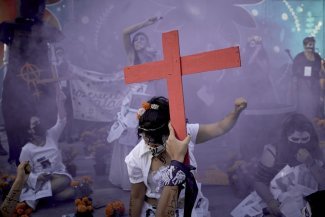Street art inspired by Picasso’s famous painting ‘Guernica’ depicting the horror of war and violence.
Hate is not the same as anger. They look similar, but they are not the same. Anger is a simple, spontaneous emotion, a survival instinct that we share with the rest of the animal world. Hate, on the other hand, is a complex feeling that is built, nurtured, that needs time and intention. That is what makes it so human.
An angry mob shouting at a bus full of refugee families, although it may look like it, is not anger. It is one hundred per cent hatred. It happened in 2016 in the small German town of Clausnitz. A group of people, organised through social networks, gathered at the gates of a reception centre to block the passage of a bus carrying men, women and child refugees. “We are the people,” they shouted at them. It was another way of saying “you are not”.
“What is it that they see?” German journalist Carolin Emcke asked herself. “Why is it that these people do not see human beings on the other side of the bus window?” To find an answer to her question she wrote a book – Against Hate – in which she warns that “rejection of the ‘other’ has always existed, but something has changed. Now the hate is open and unabashed, free of all restraint”.
According to the famous Canadian psychologist Steven Pinker, we live in the “most peaceful era” in human history. Yet the number of crimes and attacks motivated by hatred and intolerance is constantly on the rise.
Data from the Organization for Security and Cooperation in Europe shows how such incidents have doubled over the past five years. In 2017 alone, more than 8,000 cases were registered in the United States, 7,900 in Germany, 3,400 in the Netherlands, 1,500 in France and 1,400 in Spain. The record is indisputably held by the United Kingdom, with 95,000 cases. That the increase should coincide with Brexit is no coincidence.
Racism, xenophobia, homophobia and antisemitism are, in that order, the main drivers behind these crimes. It is the result of an increasingly polarised society, where divisive identity politics is surging and public debate is becoming increasingly heated and brutish, with the help of political leaders, and both traditional and social media. We may well be living in the most peaceful era ever, but we tread with the uncertainty and fear of those walking through a minefield.
Constructing the ‘enemy’
Hate is not a crime, it is an emotion. The crime is the act of assaulting, threatening, attacking, discriminating against or exercising any type of violence against someone. If, in addition, this violence is inflicted on a person simply for being an immigrant, a homosexual or Jewish, for example – for belonging to a group that is perceived as ‘different’ – then it is called a hate crime.
Those who hate do not see people with names and faces, they see categories, abstract enemies – foreigners, Muslims, Roma people. This is how they dehumanise their victims.
“When a hate crime is committed against a person, a message is actually being sent out to all those in the group targeted. And that adds to the gravity of it,” explains Esteban Ibarra, president of the Movimiento contra la Intolerancia, an association founded in Madrid in 1993 to combat intolerance after the murder of Lucrecia Pérez, the first recognised victim of racism and xenophobia in Spain.
According to Ibarra, more complaints are now being filed because there is greater visibility of the problem and better instruments to prosecute these crimes. In Spain, for example, there are specialised public prosecutors’ offices in all the provinces. Most cases, however, never reach court, be it due to the victim’s lack of understanding, fear or distrust.
“There was criminal xenophobia 30 years ago, and it was more acute than now,” admits Ibarra, “But they were minorities, neo-Nazi and racist groups who went out to hunt down immigrants or gay people. There are no hunts now, but there is a general climate of intolerance, a pervasive violence.”
David Docal, a specialist in violent urban groups and director of the Centre for Studies and Initiatives on Discrimination (CEIDIV), shares this view. “These groups - with their neo-Nazi but also anti-system ideology – are on hold, they are stagnant, but they have found another way of spreading their message, through music, for example.”
Docal is referring to people linked to groups of football ultras, connected worldwide through the internet. “Their symbols (such as swastikas) have disappeared from the stadiums, but not from beyond their walls. All that is now latent.”
Poisonous words
Around 10,000 toxic tweets – capable of spreading hatred – circulate on social networks every day, and that’s only in Spanish. Sneers and attacks go viral at breakneck speed as legions of haters push their way into the global conversation. They are usually narcissistic types who hide behind anonymity to break free of their inhibitions, but some are simply bots.
“There are many accounts with fake identities, social media mercenaries. Behind them, there is always deliberate political manipulation,” says Natalia Monje, a communicator specialising in hate speech.
Regardless of who is behind it, it is clearly a phenomenon that is growing exponentially, so much so that the United Nations has issued a warning. At the moment, there is no obvious link between hate speech and hate crime, but it is nevertheless clear that words are not harmless.
In 2018, a paper entitled Fanning the Flames of Hate analysed more than 3,000 violent attacks against refugees in Germany. The conclusion was clear: xenophobic comments on Facebook had clearly lit the fuse.
Today, speech that directly or indirectly incites discrimination or violence on the grounds of hatred are prosecuted and punished under criminal law. Facebook, Twitter, YouTube and Microsoft have also pledged to review requests for content to be removed within 24 hours.
For some experts in criminal law, these measures have a dark side. Since hatred is such an ambiguous concept, it could be exploited to limit freedom of expression, to censor humour, to punish ideological adversaries. “Right now, almost any utterance can be criminalised. Even if it’s a joke,” says Juan Luis Fuentes, professor of criminal law at the University of Jaén. “We end up not really protecting vulnerable groups but the moral majority.”
In his view, criminal prosecution should be reserved for slander, threats or public incitement to violence. All other offensive comments should be dealt with through civil or administrative channels, through which penalties can be issued but not prison sentences. Fuente, nonetheless, insists: “Society has to learn to live with this type of discourse and learn to tackle it differently.”
This is where non-judicial ways of dealing with this toxic discourse come into play, including education,fact-checking and the construction of new narratives. This is the approach Natalia Monje is working on as part of the cibeRespect project.
“We do not respond to hatred, we present a different story. We have learnt that people cannot always be reached by data. That’s why we have to trigger other emotional drivers, to make people put themselves in the other person’s shoes.”
The hostility on social media is not only fuelled by professional haters, there are thousands of people who are perfectly capable of taking part in a digital pile-on at any given moment. Sociologist Miguel del Fresno calls it collective bullying. “We can all be collective bullies. In the networked world, algorithms feed polarisation. Debates are more and more heated,” he says.
This is not, of course, limited to the internet. “We all, in one way or another, have our intolerances and rejections,” says Ana María López, a sociologist and author of an international study that tries to measure our level of tolerance in our immediate surroundings. People in 59 countries were asked: “Who would you not like to have as neighbours?”
The most common response was drug addicts, followed by heavy drinkers. Immigrants, for example, came sixth on the list. “Those most rejected were those with acquired identities,” explains the sociologist, “Those who have personally taken the decision to be that way, such as drug addicts. There is a large burden of blame.”
There is also an increasingly common but less obvious type of discrimination: political discrimination. One in four Americans prefers their neighbours to have the same political views. Some also said they would be unhappy if a family member married a person with a different party allegiance. “Racist exclusion bothers us all as a society, but we are more tolerant of political discrimination,” says Antonio Gaitán, a researcher at the Carlos III University in Madrid.
Recent research in which he took part shows that, on both sides of the ideological divide, right and left, there are ever more “moral absolutists”, i.e. people who are convinced that their values are the only morally correct ones, leading them to exclude people who have different values from their lives.
“We do not yet know what the long-term consequences of this kind of discrimination will be,” warns Gaitan. What we do know is that political parties have an interest in fuelling it right now. “Politicians have very strong motives to continue polarising,” he adds, “The absolutist electorate is more loyal and committed.”
There are no quick or easy solutions to hate crimes, just as they cannot be fought without first tackling these everyday hates. This is the same conclusion that Carolin Emcke reaches in her book. The only way to confront hate is to resist its spread/“reject the invitation to contagion”.










